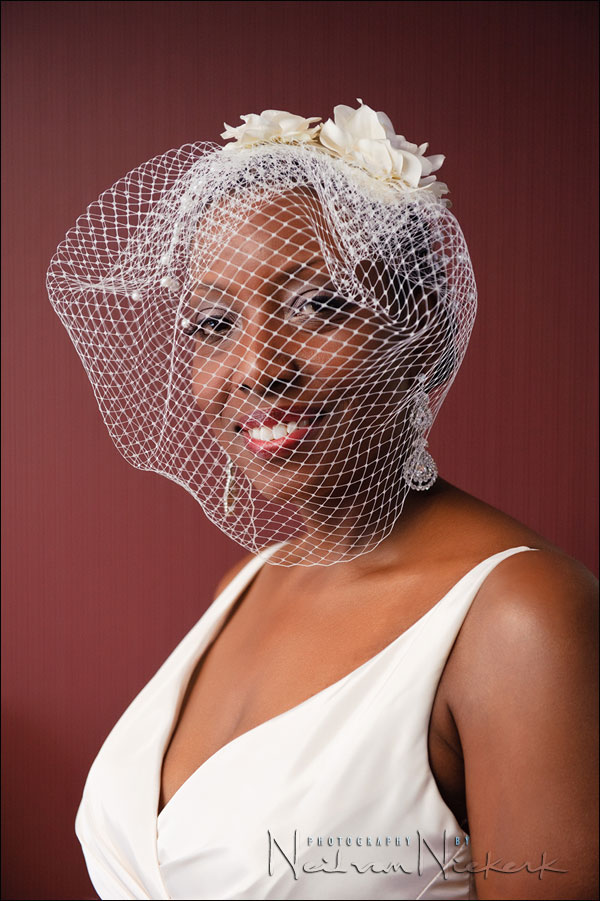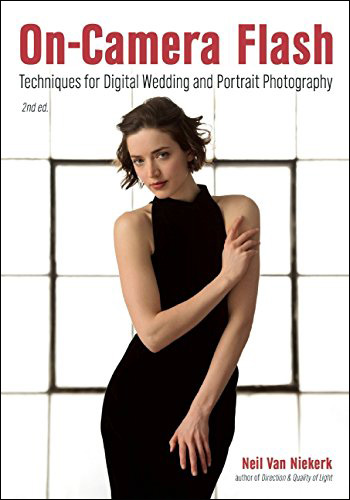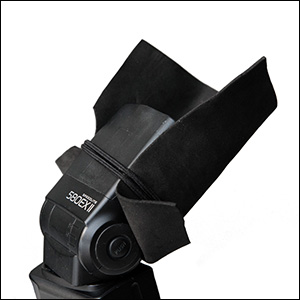
Bounce flash photography – bridal portrait
As another example of bounce flash technique, here is a portrait of the bride from a recent wedding. The technique is quite simple, and should be obvious by now to regular readers of the Tangents blog:
I used a wide aperture, focused on the eye closest to the camera .. and bounced my flash towards the bride, but blocked by the black foamie thing. No direct flash. No diffuser cup. No tupperware on your flash.
Because of this indirect directional light, we have this broad swathe of light coming in from camera-left. The intention was to mimic window light. The nearest window didn’t have much impact though on the final image. I was more concerned by getting a clean enough background, devoid of hotel-room clutter. I wanted that deep red wall-paper behind her as the single background element. A simple composition to help make the image more striking.
Focusing was tough, since the bird-cage veil got in the way. So I had my assistant delicately lift the veil. As soon as I grunted a “got it” to indicate that I’ve locked focus properly, he would gently drop the veil into position again. I could then fire off a few frames. And there we have it – a strikingly effective, yet simple portrait of the bride.
On-Camera Flash Photography – revised edition
This book is explains a cohesive and thorough approach to getting the best from your on-camera speedlight.
Particular care was taken to present it all with a logical flow that will help any photographer attain a better understanding of flash photography.
You can either purchase a copy via Amazon USA and Amazon UK, or can be ordered through Barnes & Nobles and other bookstores. The book is also available on the Apple iBook Store, as well as Amazon Kindle. Also check out the Amazon Kindle store.
Learn more about how the cover image was shot.
Camera settings & photo gear used (or equivalents)
- 1/125 @ f4 @ 1250 ISO
- Nikon 70-200mm f2.8 AF-S VR II / Canon EF 70-200mm f/2.8L IS II
- Nikon SB-910 Speedlight / Canon 600EX-RT Speedlite
- a BFT (black foamie thing)
On-camera flash modifier – the black foamie thing
The BFT is held in position by two hair bands (Amazon), and the BFT is usually placed on the under-side of the flash-head.
The linked articles will give clearer instruction, especially the video clip on using the black foamie thing.


Neil
Boy this is a incredible shot and the first thing I asked was were was his focus point, second such a beutiful bride with a smile that stops and make you look.
I really love your bounce flash! can you say how your wb was set?? on this?
really really like this.
Thanks John
Hey Neil,
Some questions:
1. How much of your exposure is flash and how much is ambient? In other words, if you had turned off your flash in this instance, would the frame have been black? What ratio do you usually shoot for when you’re taking an image like this.
2. How important do you feel a longer lens is to taking a nice portrait? Do you think the compression really makes a difference?
Thanks for any help
-Nick
P.S. I’m only asking because I’ve been attempting your techniques, and I find that I don’t always get quite as stellar end results!
Instead of lifting the veil, wouldn’t it be easier to focus on the veil and move the camera 1 inch closer?
Hi:
My question is: why did you aim at such a high ISO if you didn’t “care” about ambient light on this shot?
Is it to save batteries on yout speedlight? In this kind of situation, I also find myself shooting at high ISO for no reason… :) Even with the most recent cameras, it’s always best to shoot at low ISO settings for the picture’s quality sake.
Thanks,
André P.
I pack a black foamy thing in each of my bags, and practice this indirect flash technique whenever possible. Before I shoot, I look at the billiard shot – what my light will be bouncing off of before it hits the subject. Often, I am faced with dark walls like the one behind this subject. Are you selecting locations where you can get a good white wall to bounce the light onto the subject?
Neil,
what color was the wall you were bouncing off of? I’m assuming it wasn’t the same red color, otherwise you’d be a color cast. Did you simply position in a place with a white wall available? Any other advice for removing color cast?
Steve
thanks for sharing the info about how you were able to determine focus on her face by lifting the veil, not sure if I would have thought of that on my own :)